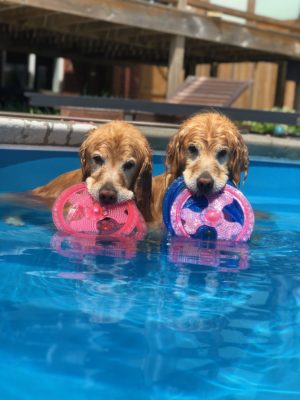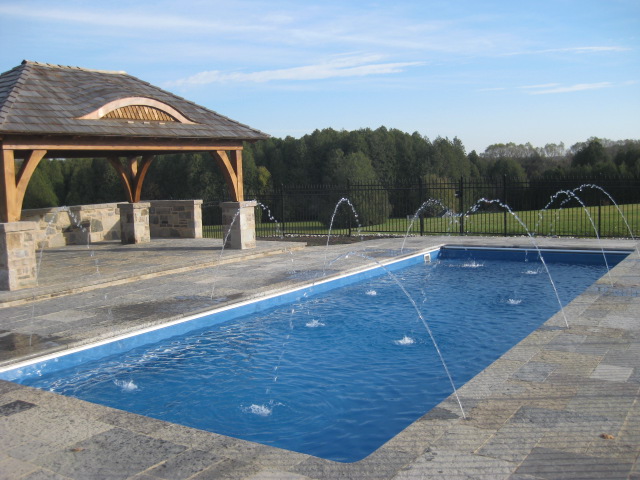Many people look to a fiberglass over of a vinyl-lined pool due to worries that their furry, water loving friends and their sharp claws will inadvertently rip a liner. While this is a legitimate fear, people don’t often think about the effects swimming in the pool can have on their pet. While it’s true that your dog won’t destroy your fiberglass pool, there are several ways you can make swimming healthier for your dog.
Many dogs enjoy a dip in cool water and will take a few gulps to quench their thirst at the same time. But should they really be drinking that pool water? Depending on your pool setup there may be a couple concerns. Number one is the chlorine level in the water – no one (man or beast) should be drinking or swimming in water with loads of chlorine in it. The safe operating level of chlorine in your pool is between 1-3 ppm (parts per million), but shocking your pool and not monitoring your levels closely can result in levels well above that range. What about salt water pools – are they any safer? The answer is no – the chlorine level can still be high in a salt water pool, with the added problem of the salt content in the water. While the salt level of a salt water pool is fairly low (typically between 2000-4000 ppm, less than half that of tears and 1/10 of the ocean), it is still not ideal to drink water with added salt.
So what are your other options?

Reducing chlorine content is the best way to improve both your and your pets bather experience. Chlorine is a very effective sanitizer and in Canada we are not currently allowed to sell or promote pool sanitation systems that are not chlorine (or bromine) based, but there are other ways to improve the cleanliness of your pool water that can make your swims a lot more comfortable.
The first step is to improve your filtration. Physically removing more dirt, debris, pollen, bather wastes, hair and products like sunscreen means you wont require as much chlorine to keep the pool clean. We highly recommend choosing a cartridge filtration system. Cartridge filters use a fabric-like media to trap debris down to 10 microns in size compared to the 20 microns that a sand filter can potentially catch. A large cartridge filter systems can also move more gallons per minute than a comparable sand filter, so you can filter more water in less time. Overall you will be left with cleaner water that requires less chlorine, algaecide, clarifier, and shock treatment, as well as less frequent cleaning and no backwashing.
The next step is to add a secondary purification system such as ozone or UV. You will still be relying on chlorine as your primary sanitizer but incorporating ozone or UV into your system will allow you to keep your chlorine level as the lowest testable levels, typically 0.5 to 1 ppm. While comparable for their benefits, UV and ozone are different in how they work. Ozone systems use UV light to create ozone (O3) out of oxygen (O2). Ozone is a very reactive and acts as a powerful oxidizer that will burn off unwanted organic contaminants from your pool water. In comparison, exposing pool water to the UV-C light of a UV system will alter the DNA of bacteria and other microscopic contaminants, causing them to be unable to reproduce and die. All of this happens away from the pool at your equipment pad where you can’t see it and you can then simply enjoy swimming in clean, purified water. Pools are not the only place you will find these types of purification systems – ozone is widely used to purify bottled drinking water, and UV drinking water systems are readily available to purchase for homes, RV’s and boats. You will feel more comfortable knowing you, your family and your furry friends are swimming in the cleanest water possible.
No matter what system you use, it is always a good idea to dry out those floppy ears and offer your pet lots of non-pool water for them to drink, especially on those hot summer days. We are firm believers that even pets should get to enjoy swimming in your new fiberglass pool!




